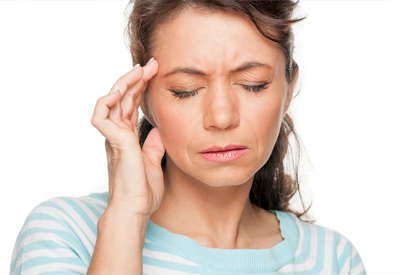STOP HEADACHES & JAW PAIN TODAY WITH OUR TMJ TREATMENTS!
 Temporomandibular Joint Disorder (TMJ) occurs when there is a problem with the functioning of the jaw, jaw joints, and surrounding facial muscles that control the movement of the jaw. The temporamandibular joint is a hinge joint connecting the lower jaw to the skull. This joint is located right in front of the ear on each side of the head, which is why teeth grinding causes migraines in many people. The muscles attached to the jaw allow us to move the jaw from side-to-side and up and down. This level of flexibility also allows us to chew, talk, and yawn with ease.
Temporomandibular Joint Disorder (TMJ) occurs when there is a problem with the functioning of the jaw, jaw joints, and surrounding facial muscles that control the movement of the jaw. The temporamandibular joint is a hinge joint connecting the lower jaw to the skull. This joint is located right in front of the ear on each side of the head, which is why teeth grinding causes migraines in many people. The muscles attached to the jaw allow us to move the jaw from side-to-side and up and down. This level of flexibility also allows us to chew, talk, and yawn with ease.
WHAT IS TMJ?
Many people who suffer from TMJ experience severe pain and discomfort. Some do not realize that teeth grinding causes migraines because the pressure placed on the jaw affects the jaw joints. The pain from TMJ can last for a few months or for several years. More women experience TMJ pain than men, and the disorder is more common in people between 20 and 40 years of age.
COMMON SYMPTOMS OF TMJ:
• Pain or tenderness in the face, jaw joint region, neck, shoulders, and in or around the ear when chewing, speaking, or yawning
• Limited ability to open the mouth wide
• Jaws that get “stuck” or get “locked” in an open or closed-mouth position
• Clicking, popping, or grating sounds when the mouth is opened or closed
• Feelings of tiredness in the face and neck
• Difficulty chewing
• Uncomfortable feeling when biting
• Facial swelling
• Frequent toothaches
• Headaches and neck aches
• Dizzy spells
• Earaches
• Hearing problems
• Upper shoulder pain
• Ringing ears
CAUSES OF TMJ The main cause of TMJ is still unknown, but experts believe the symptoms are a result of problems in the muscles of the jaw or with parts of the joint. Some of the known factors that contribute to TMJ include:
• Any type of trauma to the face or jaw
• Grinding of the teeth (bruxism)
• Jaw clenching
• Osteoarthritis
• Rheumatoid arthritis
It is also important to note that teeth grinding causes migraines and can affect bite. If you have a habit of grinding your teeth, talk to Dr. Boyajian about treatment options.
TMJ TREATMENT OPTIONS
In many cases, TMJ symptoms will go away on their own because the jaw joint has a chance to recover when you are not chewing food or gum. At-home TMJ treatment options include taking anti-inflammatory medication, eating soft foods, and applying warm compresses to the area where you are experiencing pain.
If your symptoms do not go away on their own, medical TMJ treatment may be necessary. Dr. Boyajian can show you how to perform some basic muscle stretching and relaxation exercises that help to relax the jaw. He may also recommend a fitting with a splint or bite plate that fits over your upper and lower teeth like a mouth sports guard. The splint is designed to reduce clenching or grinding at night, and can help to reduce muscle tension.
If non-invasive treatments fail to work, you may need to undergo a more invasive procedure. Cortisone shots can help to relieve pain and inflammation. A very small percentage of patients will require jaw joint replacement surgery to replace the jaw joint with an artificial implant.
If you want to learn more about how teeth grinding causes migraines or are experiencing several TMJ symptoms, talk to Dr. Boyajian about TMJ treatment options.
